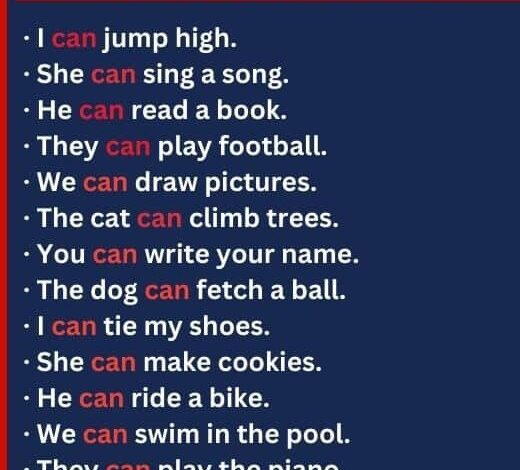The Many Faces of "Can"

The word “can” is one of the most versatile in the English language. It appears in casual conversations, formal speeches, and even in creative writing. People often underestimate how much meaning can be packed into a single syllable. “Can” can express ability, permission, possibility, and even suggestion. For example, a child might say, “I can ride a bike,” proudly expressing new skill. At work, a manager might ask, “Can you finish the report by Friday?” In this case, “can” becomes a polite way to inquire about someone’s availability or capability.
Interestingly, “can” also functions as a noun. Think of the common food storage item—a tin can. Soup, beans, and soda all come in cans. These containers can be made of aluminum, steel, or other recyclable materials. People often crush cans before recycling to save space. Recycling cans can significantly reduce environmental waste. One recycled aluminum can saves enough energy to run a television for three hours.
In some cases, “can” serves as a verb, meaning to preserve food by sealing it in a can or jar. In rural areas, families still can fruits and vegetables for the winter. Canning peaches or tomatoes can be a long but rewarding process. The satisfaction of opening a home-canned jar of pickles in January is hard to beat. It’s amazing what simple tools and patience can accomplish in the kitchen.
“Can” can also represent potential. For instance, someone might say, “This idea can change the world.” In innovation, belief in what can be done fuels progress. Entrepreneurs often say, “If you can dream it, you can build it.” That belief turns simple concepts into revolutionary products. Without belief in what we can do, we stagnate.
Sometimes, “can” introduces doubt or caution. For example, “This can go wrong if we’re not careful.” Used this way, it serves as a reminder that not all outcomes are positive. Engineers and planners often evaluate what can fail before launching a project. Identifying potential risks can prevent major disasters. Just as hope is important, so is preparation.
In writing, authors use “can” to open possibilities for characters. A protagonist can overcome great odds. A villain can become a hero. Emotions can shift, and lives can change in a single chapter. That’s the beauty of storytelling—it shows what the human heart can endure and what the human mind can imagine.
Even in science, the word “can” plays a major role. Scientists ask, “Can we cure this disease?” or “Can this experiment prove our hypothesis?” Every breakthrough begins with a question about what can be done. Great minds push boundaries by exploring what can be known. In this sense, “can” becomes a beacon of curiosity and progress.
In education, teachers emphasize what students can achieve. “You can solve this problem,” they say, offering encouragement. Positive reinforcement can transform a struggling student’s attitude. Educators know that belief in a student’s ability can be the difference between failure and success. Motivation can unlock hidden potential.
Socially, “can” opens the door to cooperation. “Can we work together on this?” is a question that fosters teamwork. Collaboration can produce better outcomes than isolated efforts. When people realize what they can do together, they often achieve more than they thought possible. Unity can amplify individual strengths.
In relationships, “can” becomes a tool of empathy. “Can I help you?” or “Can I listen?” shows willingness to support others. These small phrases can build trust and compassion. Emotional connection can be strengthened through such simple offers. Love can grow from a simple act of kindness.
Sometimes, “can” expresses restraint or rules. “You can’t go there,” a sign might say. In these contexts, “can” is used to define boundaries. While some restrictions can feel limiting, they can also protect us. Laws and regulations can create order in society. Without structure, chaos can arise.
Philosophically, we ponder what the mind can conceive. Can happiness be sustained? Can peace be achieved? These big questions often go unanswered, but the asking itself can be enlightening. Philosophy thrives on exploring what can and cannot be known. Such thinking can change perspectives.
Technology shows what the human mind can build. We can send rockets into space. We can talk to anyone around the world in seconds. Artificial intelligence can now perform tasks once thought impossible. As our tools improve, so too can our lives. But we must also consider how technology can impact society.
On the darker side, “can” reminds us of what harm can be done. Words can hurt. Actions can destroy. Misinformation can spread rapidly. But awareness of these dangers can lead to change. Knowing what can go wrong can guide us toward what can go right.
In art, “can” reflects freedom. An artist can paint dreams. A musician can express emotion through sound. A poet can capture a lifetime in a few lines. Creativity can flourish when boundaries are removed. Expression can bring healing and connection.
Politically, leaders often speak of what their countries can become. Promises are framed with “we can” to inspire citizens. Movements begin with the belief that things can change. Hope can be contagious. A vision of what can be achieved can unite millions.
Finally, “can” reflects possibility in its purest form. We all wonder what we can become. We question what we can accomplish in our time. Some can make peace, others can build. Each of us can contribute something unique. The only real limit is what we believe we can or cannot do.



